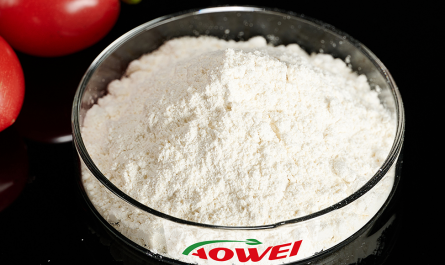What is the difference between α-Naphthaleneacetic acid and sodium naphthalene acetate?
The core difference between α-Naphthaleneacetic acid (NAA) and sodium naphthalene acetate (SNA) lies in their chemical form and solubility: Naphthaleneacetic acid is a free acid, while sodium naphthalene acetate is its sodium salt form. Both exert their effects in plants by releasing Naphthaleneacetic acid ions, and their functions are the same. However, sodium naphthalene acetate has become the mainstream formulation due to its superior water solubility and ease of use.

Chemical Properties and Structural Differences
Naphthaleneacetic acid (NAA): With the chemical formula C₁₂H₁₀O₂, it is a free organic acid. At room temperature, it is a white crystalline or powdery substance, poorly soluble in water, and requires an organic solvent (such as ethanol) to dissolve. Sodium naphthalene acetate (SNA): With the chemical formula C₁₂H₉O₂Na, it is the sodium salt of naphthaleneacetic acid. It appears as white granules or crystalline powder, readily soluble in water (up to 53.0 g/100 ml), and exhibits both water and oil solubility, allowing for direct formulation into aqueous solutions, emulsifiable concentrates, etc.
Mechanism of Action and Function Consistency:
Both sodium naphthaleneacetic acid and naphthaleneacetic acid exert their effects in plants through hydrolysis, releasing naphthaleneacetic acid ions (C₁₂H₉O₂⁻). Their functions are completely identical:
As broad-spectrum plant growth regulators, they promote cell division, induce adventitious root formation, increase fruit set, alter the ratio of male to female flowers, and enhance plant resistance to stresses (such as drought and cold).
The applications are similar, including fruit enlargement, rooting of cuttings, flower and fruit preservation, and increasing crop yield. For example, the effects are consistent on fruit trees (such as peppers and beans) and vegetables (such as radishes and cucumbers).
Differences in Solubility and Application Practice
Solubility:
Naphthaleneacetic acid has excellent water solubility and can be directly diluted for use, making it easy to handle. Naphthaleneacetic acid requires organic solvents, making preparation complex and prone to leaving impurities.
Purity and Safety:
High-purity Naphthaleneacetic acid (≥98%) has fewer impurities and is effective at low concentrations (e.g., 5 ppm), making it less likely to cause phytotoxicity. Ordinary Naphthaleneacetic acid or Naphthaleneacetic acid may contain 20% organic impurities, requiring higher concentrations (e.g., 20 ppm), which can easily cause black spots or even death in young leaves or seedlings. Compatibility: High-purity Naphthaleneacetic acid can be compounded with insecticides and fertilizers (such as sodium nitrophenolate) to enhance synergistic effects; however, the compatibility of Naphthaleneacetic acid with other pesticides is limited.

Chemical Properties and Structural Differences
Naphthaleneacetic acid (NAA): With the chemical formula C₁₂H₁₀O₂, it is a free organic acid. At room temperature, it is a white crystalline or powdery substance, poorly soluble in water, and requires an organic solvent (such as ethanol) to dissolve. Sodium naphthalene acetate (SNA): With the chemical formula C₁₂H₉O₂Na, it is the sodium salt of naphthaleneacetic acid. It appears as white granules or crystalline powder, readily soluble in water (up to 53.0 g/100 ml), and exhibits both water and oil solubility, allowing for direct formulation into aqueous solutions, emulsifiable concentrates, etc.
Mechanism of Action and Function Consistency:
Both sodium naphthaleneacetic acid and naphthaleneacetic acid exert their effects in plants through hydrolysis, releasing naphthaleneacetic acid ions (C₁₂H₉O₂⁻). Their functions are completely identical:
As broad-spectrum plant growth regulators, they promote cell division, induce adventitious root formation, increase fruit set, alter the ratio of male to female flowers, and enhance plant resistance to stresses (such as drought and cold).
The applications are similar, including fruit enlargement, rooting of cuttings, flower and fruit preservation, and increasing crop yield. For example, the effects are consistent on fruit trees (such as peppers and beans) and vegetables (such as radishes and cucumbers).
Differences in Solubility and Application Practice
Solubility:
Naphthaleneacetic acid has excellent water solubility and can be directly diluted for use, making it easy to handle. Naphthaleneacetic acid requires organic solvents, making preparation complex and prone to leaving impurities.
Purity and Safety:
High-purity Naphthaleneacetic acid (≥98%) has fewer impurities and is effective at low concentrations (e.g., 5 ppm), making it less likely to cause phytotoxicity. Ordinary Naphthaleneacetic acid or Naphthaleneacetic acid may contain 20% organic impurities, requiring higher concentrations (e.g., 20 ppm), which can easily cause black spots or even death in young leaves or seedlings. Compatibility: High-purity Naphthaleneacetic acid can be compounded with insecticides and fertilizers (such as sodium nitrophenolate) to enhance synergistic effects; however, the compatibility of Naphthaleneacetic acid with other pesticides is limited.



